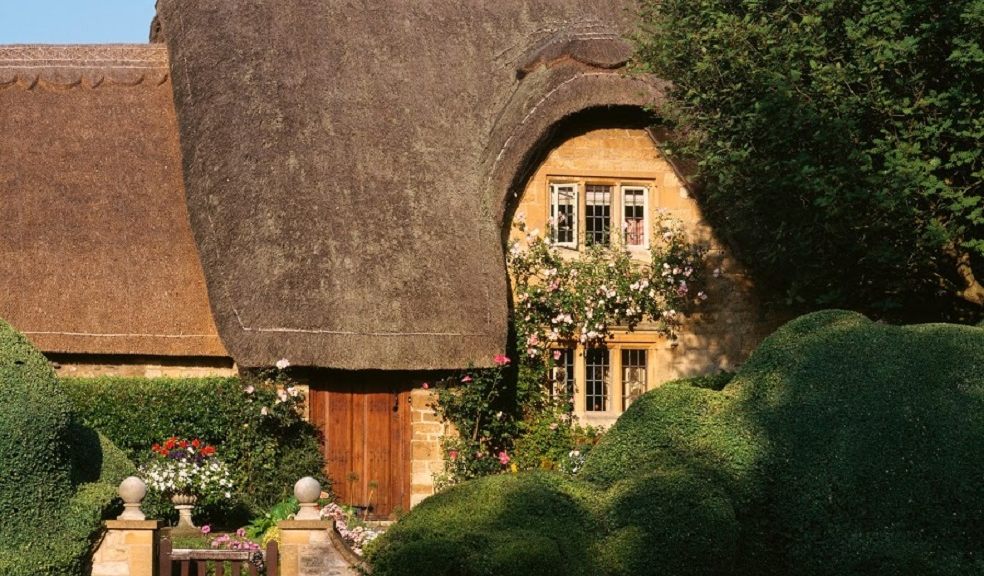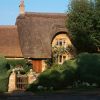
Wood burning stoves proved to be a fire risk in buildings with thatched roofs
Thatched roof buildings that are fitted with wood burning stoves are at greater risk of fire than those with open fires and new research funded by Historic England and NFU Mutual and undertaken by the Fire Protection Association has now explained why.
Historic England, in partnership with the thatch insurer NFU Mutual, has funded a three year programme of research which included full-scale fire tests. The results show that, because of the higher temperatures and flue velocities associated with the use of a wood-burning stove, thatch could be set alight by large sparks and embers ejected from the chimney. An open fire is not as hot and produces smaller sparks and embers, making it less dangerous.
Since the 1990s, the number of fires in thatched roofed buildings has risen significantly and in the past decade more than 500 thatch roofed buildings in England have been damaged or even destroyed by fire; most of these are listed buildings.
One of the greatest risks occurs when a wood-burner is used in a chimney in which a bird’s nest has been built, as often happens if there is a cold snap in early spring. The research also demonstrates that fires could be started by hot flue gases leaking into the thatch layer through defects in the chimney stack, especially if the flue is partially blocked.
This research has also disproved a widely-held belief that thatched roof fires were predominately started by heat being transferred from flue gases through solid chimney brickwork and setting light to the surrounding thatch layer. The laboratory trials showed that the temperature of chimney brickwork at roof level, even when the wood-burner is being operated at maximum output over prolonged periods, is actually much lower than previously assumed by the proponents of the ‘heat transfer’ theory.
In response to these findings, Historic England has produced new guidance on measures to reduce the risk of fires in thatched properties with wood burning stoves. The guidance includes sweeping chimneys regularly to prevent build-up of tar and soot, checking the distance between the top of the chimney pot and the thatch, fitting bird guards to prevent them nesting in chimneys, fitting a stove pipe temperature gauge and installing a suitable flue liner.
NFU Mutual, as the insurer of thousands of thatched homes, has found a high proportion of thatch fire claims involve wood burning stoves.
Alison Henry, Head of Building Conservation and Research for Historic England said: “We want to end the loss of valuable historic buildings and the associated misery for homeowners by reducing the risk of fire in thatched buildings fitted with a wood-burning stove. We know that many people love their wood-burners, but there is no doubt that they pose a risk to thatched buildings and we recommend that they are not used. If a wood-burner is used, implementing the measures described in our new guidance will reduce the risk of fire, but cannot eliminate it.”
Anca Dutu, Home Insurance Specialist at NFU Mutual, said: “An iconic part of our rural heritage - the thatched cottage - is in danger of going up in smoke. People would expect that an enclosed stove would be less of a fire risk than an open grate but the results show the opposite when they are fitted, used or maintained incorrectly. Statistically thatched homes are no more likely to catch fire than those with conventional roofs; however, if a thatched roof does ignite, the resulting fires are rapid and devastating.”
Dr James Glockling, Technical Director of the Fire Protection Association: “As a thatched house owner myself, in light of this work, I have opted to remove our wood burning stove and adopt an alternative form of decorative and functional heating. It has not been a popular decision with my family, and for those whom this approach seems too draconian, the guidance we have developed will go some way to reducing risks where used.”
In the South West, the Devon and Somerset Fire & Rescue Service (DSFRS) has set a target of reducing fires in thatched roof buildings by 25% in the next 12 months. The DSFRS, together with Historic England and the Institute of Historic Building Conservation, held a seminar late last year on reducing the risk of fire in thatched buildings at the Fire Service headquarters near Exeter and more are planned.
Historic England will be exhibiting at the Listed Property Show at Olympia in London on 9-10 February 2019, providing expert advice and guidance to owners of historic buildings.



















